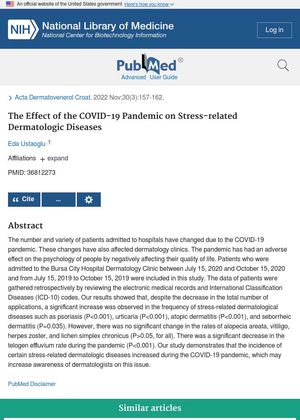The Effect of the COVID-19 Pandemic on Stress-Related Dermatologic Diseases
November 2022
in “
PubMed
”

TLDR The COVID-19 pandemic increased some stress-related skin diseases but didn't affect others.
The study conducted at Bursa City Hospital Dermatology Clinic between July 15, 2020 and October 15, 2020, and from July 15, 2019 to October 15, 2019, found that the COVID-19 pandemic has significantly increased the incidence of certain stress-related dermatologic diseases. Despite a decrease in the total number of applications, there was a significant increase in the frequency of diseases such as psoriasis, urticaria, atopic dermatitis, and seborrheic dermatitis. However, there was no significant change in the rates of alopecia areata, vitiligo, herpes zoster, and lichen simplex chronicus. Interestingly, there was a significant decrease in the telogen effluvium rate during the pandemic. This suggests that the pandemic has had a varied impact on different dermatological conditions.